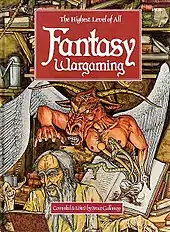Fantasy Wargaming
Fantasy Wargaming is a role-playing game published by Patrick Stephens Limited (U.K.) in 1981.

Description
Fantasy Wargaming is a fantasy system set in medieval Europe.[1] The first half of the book introduces role-playing concepts and describes medieval Europe's history, economy, religion, magic, etc.[1] The latter half contains the game rules, covering character creation (flavored by astrology), social class, combat (where PC behavior and morale is often controlled by the dice), large scale combat, magic (based on actual medieval concepts), clerics and divine power, and monsters.[1]
Publication history
Fantasy Wargaming was edited by Bruce Galloway and published by Patrick Stephens Limited in 1981 as a 222-page hardcover with cover and interior art by Lawrence Heath.[1] A second edition was published by Stein & Day in 1982.[1] A third edition was published by Doubleday Book Club in 1982 as a 300-page digest-sized hardcover.[1]
This book should not be confused with Fantasy Wargaming by Martin Hackett, which was published in 1990 by Patrick Stephens Limited.
Reception
Fantasy Wargaminging was not well received by many critics, some of whom called it the worst role-playing game ever published.
W.G. Armintrout was one of those critics, writing in The Space Gamer No. 56 "I've never seen a worse game. It's too bad that many people's first experience with FRP may be through buying Fantasy Wargaming through the Science Fiction Book Club."[2]
In his 1990 book The Complete Guide to Role-Playing Games, game critic Rick Swan called this "Among the worst RPGs ever published. Fantasy Wargaming shows just how badly a game can go astray." Swan called the historical material "rambling, dry, and mostly superfluous to the game it allegedly supports." Swan did not like the complicated character generation system "pointlessly based on astrology." He also found "the magic system is nearly incomprehensible, requiring players to navigate divination tables, ethereal influences, mana accumulation, and a host of other difficult concepts." Swan concluded by giving this book a very poor rating of only 1 out of 4, saying, "Top it off with some distasteful references to Black Masses and you've got a game that I wouldn't touch with a ten-foot broomstick."[3]
Lawrence Schick, in his 1991 book Heroic Worlds, noted that the game rules were "rather complex" and the magic system "quite complicated".[1]
Street Vincent, writing in Adventurer Magazine No. 2, had a milder view, finding "the religion/magic system is really what makes FW." Vincent concluded, "FW is not a game for beginners, but is a suitable alternative for anybody seeking a realistic, coherent fantasy game."[4]
In Issue 15 of Commodore User Magazine, John Ransley called this book "a treasure trove of information about creating scenarios and characters, playing rules, combat, magic and spells and almost every other element of the dungeonmaster's art."[5]
Other reviews and commentary
- Different Worlds #18 (Jan., 1982)
- Alarums & Excursions (Issue 326 - Oct 2002)
References
- Schick, Lawrence (1991). Heroic Worlds: A History and Guide to Role-Playing Games. Prometheus Books. p. 157. ISBN 0-87975-653-5.
- Armintrout, W.G. (October 1982). "Capsule Reviews". The Space Gamer. Steve Jackson Games (56): 29.
- Swan, Rick (1990). The Complete Guide to Role-Playing Games. New York: St. Martin's Press. p. 84.
- Vincent, Street (June–July 1986). "Shop Window". Adventurer. No. 2. p. 15.
{{cite magazine}}: CS1 maint: date format (link) - Ransley, John (December 1984). "Shop Window". Adventurer. No. 15. p. 54.